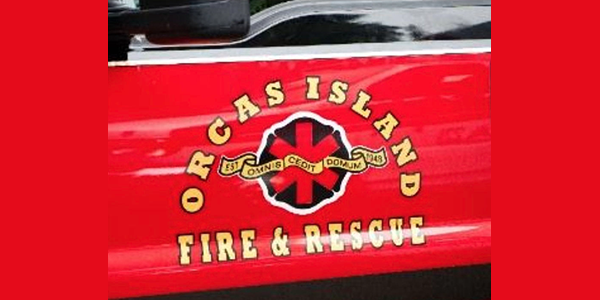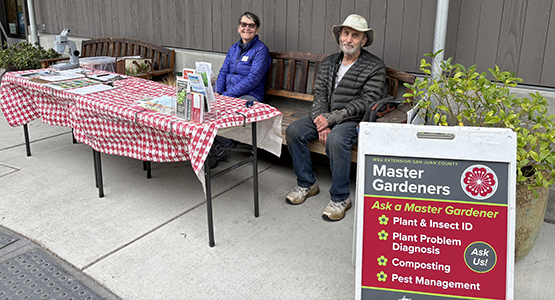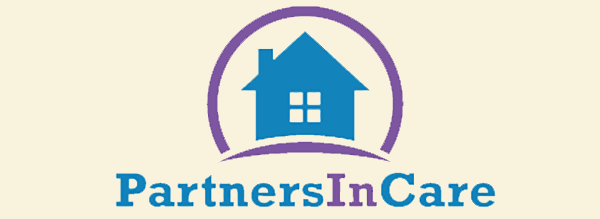— by Margie Doyle —
The Eastsound Water Users Association presented its proposed water rate structure to residential users on Wednesday, Jan. 17. The proposal comes after months of weekly meetings among Board members Joe Cohen, Steve Miller and Jim Nelson and Members Jay Kimball and Mike Stolmeier to devise the new rate structure. This meeting was one of five being held during January to solicit member feedback.
Eastsound Water General Manager Paul Kamin presented the proposal to about three dozen residential customers, along with charts illustrating the potential impacts on different water users. He emphasized that the proposed structure, if approved by the Board, would not go into effect until Jan. 2019, so users can monitor their consumption patterns this year (2018) to take advantage of the new rate structure, and lower their rates in 2019. About half residential and commercial users will pay less under the new rates, and about half will pay more, Kamin said. He listed the values that the committee determined should be incorporated in a new rate structure:
- equity
- conservation
- seasonality
- predictable and adequate revenue
The existing rate structure was adopted in 2004, establishing the rates per ERU, the Equivalent Residential Unit. In 2016 EWUA initiated a member engagement process to discuss ways and means to more equitably share the cost of operating and maintaining the water system among the membership. Those discussions were facilitated by Fred Klein. Beginning in May 2017 the Rate Committee formed and has been meeting weekly.
The proposed new rate structure applies the same service fees to every gallon of water used by all members. The goal of the proposed rate structure is to collect 75% of service fees from the base rate and 25% of revenue from consumption charges.
In comparing rates between the current and proposed structure, there remains both a base and consumption charge; however, the proposed consumption charge applied to all water use is $4 per 1000 gal, while the $20 per 1000 gal consumption charge in the existing rate structure applied only to water use above the base allotment.
Kamin showed charts comparing costs and usage for residences, businesses and multi-residential units (such as exist in Driftwood Apartments, Alder Cottages on Lovers Lane and OPAL’s Wild Rose Meadow).
Historically, the highest 25% of residential users consume 50% of the residential water use, but pay 37% of residential service fees. This similar pattern of consumption and payment exists in commercial users. In 2017 most users (81%) averaged under 5,000 gallons, and 58% averaged less than 3,000 gallons per month. The average of all active residential accounts is 2,850 gallons per month. There are 139 inactive residential accounts, where water has not yet been hooked up. Those accounts are charged the base rate, as they may request hook-up at any time.
Kamin also announced that Eastsound Water is developing voluntary financial assistance program for community members who struggle with utility costs, similar to OPALCO’s Project Pal. Orcas Family Resource Center has agreed to manage the EWUA assistance program, which will start if/when the new rate structure goes into effect.
Kamin also addressed the progress EWUA has made in water conservation over the past 15 years during which the Association has seen a 45% reduction in water use per Equivalent Residential Unit.
2000-2 85,000 gallons per ERU per year.
2017 47,000 gallons per ERU per year.
The reduction is due “primarily to improvements in water system efficiency, with EWUA addressing leaks in the supply side of the organization,” said Kamin. He added that EWUA has invested $270,000 to install an automated meter reading system, which proves members leak detection warning and online access to their water use history that is updated daily.
In response to a member question, Kamin said that when members experience a catastrophic leak event if the leak is eliminated promptly, EWUA will reduce the surplus water use charges by 50%.
EWUA has activated an alert system in recent months to inform users when a leak is detected. Kamin said that over 200 members have been notified of detected leaks, most by email, but some by phone. However, of the 38 leaks currently being detected, 22 have persisted for more than 60 days. Kamin said that Eastsound Water can help detect leaks, however, he emphasized that the responsibility for fixing leaks belongs with the property owner.
The new rate structure improves equity among users and has been designed to be revenue neutral, generated the same revenue as the existing rate structure. Kamin says the proposed rate structure could be approved by the Board as early as Feb., but that changes would not go into effect until January 2019, to allow members to adjust to the proposed change and begin more closely monitoring their water use.
A general presentation of the proposed rate structure shared at the 2017 Annual Meeting is posted at https://eastsoundwater.org/wp-content/uploads/2017/12/2018-Rate-Structure-Presentation-WEB-PDF.pdf
He notes that Eastsound Water has also posted water saving suggestions at https://eastsoundwater.org/tips-to-save-water-and-cut-your-water-bills-in-half/
A meeting on the proposed rate structure for commercial EWUA members will be held on Wednesday, Jan. 31 at 6:30pm at the Eastsound Fire Hall. All EWUA members who missed earlier meetings are welcome to attend.
**If you are reading theOrcasonian for free, thank your fellow islanders. If you would like to support theOrcasonian CLICK HERE to set your modestly-priced, voluntary subscription. Otherwise, no worries; we’re happy to share with you.**








